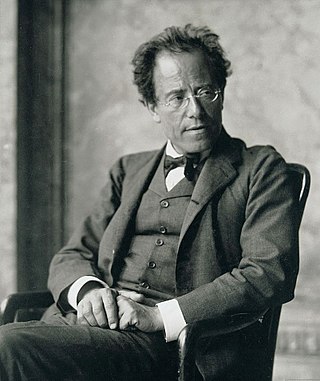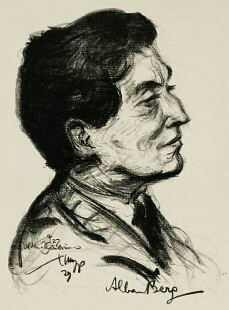
Gustav Mahler was an Austro-Bohemian Romantic composer, and one of the leading conductors of his generation. As a composer he acted as a bridge between the 19th-century Austro-German tradition and the modernism of the early 20th century. While in his lifetime his status as a conductor was established beyond question, his own music gained wide popularity only after periods of relative neglect, which included a ban on its performance in much of Europe during the Nazi era. After 1945 his compositions were rediscovered by a new generation of listeners; Mahler then became one of the most frequently performed and recorded of all composers, a position he has sustained into the 21st century.

Alban Berg's Violin Concerto was written in 1935. It is probably Berg's best-known and most frequently performed piece. In it, Berg sought to reconcile diatonicism and dodecaphony. The work was commissioned by Louis Krasner, and dedicated by Berg to "the memory of an angel". It was the last work he completed. Krasner performed the solo part in the premiere at the Palau de la Música Catalana, Barcelona, in April 1936, four months after the composer's death.

The Symphony No. 5 by Gustav Mahler was composed in 1901 and 1902, mostly during the summer months at Mahler's holiday cottage at Maiernigg. Among its most distinctive features are the trumpet solo that opens the work with a rhythmic motif similar to the opening of Ludwig van Beethoven's Symphony No. 5, the horn solos in the third movement and the frequently performed Adagietto.

The Symphony No. 1 in D major by Gustav Mahler was mainly composed between late 1887 and March 1888, though it incorporates music Mahler had composed for previous works. It was composed while Mahler was second conductor at the Leipzig Opera in Germany. Although in his letters Mahler almost always referred to the work as a symphony, the first two performances described it as a symphonic poem and as a tone poem in symphonic form, respectively. The work was premièred at the Vigadó Concert Hall in Budapest, Hungary, in 1889, but was not well-received. Mahler made some major revisions for the second performance, given at Hamburg, Germany, in October 1893; further alterations were made in the years prior to the first publication, in late 1898. Some modern performances and recordings give the work the title Titan, despite the fact that Mahler only used this label for the second and third performances, and never after the work had reached its definitive four-movement form in 1896.

The Symphony No. 8 in E-flat major by Gustav Mahler is one of the largest-scale choral works in the classical concert repertoire. As it requires huge instrumental and vocal forces it is frequently called the "Symphony of a Thousand", although the work is normally presented with far fewer than a thousand performers and the composer disapproved of the name. The work was composed in a single inspired burst at his Maiernigg villa in southern Austria in the summer of 1906. The last of Mahler's works that was premiered in his lifetime, the symphony was a critical and popular success when he conducted the Munich Philharmonic in its first performance, in Munich, on 12 September 1910.

The Symphony No. 4 in G major by Gustav Mahler was composed from 1899 to 1900, though it incorporates a song originally written in 1892. That song, "Das himmlische Leben", presents a child's vision of heaven and is sung by a soprano in the symphony's Finale. Both smaller in orchestration and shorter in length than Mahler's earlier symphonies, the Fourth Symphony was initially planned to be in six movements, alternating between three instrumental and three vocal movements. The symphony's final form—begun in July 1899 at Bad Aussee and completed in August 1900 at Maiernigg—retains only one vocal movement and is in four movements: Bedächtig, nicht eilen ; In gemächlicher Bewegung, ohne Hast ; Ruhevoll,poco adagio ; and Sehr behaglich.

The Symphony No. 2 in C minor by Gustav Mahler, known as the Resurrection Symphony, was written between 1888 and 1894, and first performed in 1895. This symphony was one of Mahler's most popular and successful works during his lifetime. It was his first major work that established his lifelong view of the beauty of afterlife and resurrection. In this large work, the composer further developed the creativity of "sound of the distance" and creating a "world of its own", aspects already seen in his First Symphony. The work has a duration of 80 to 90 minutes, and is conventionally labelled as being in the key of C minor; the New Grove Dictionary of Music and Musicians labels the work's tonality as C minor–E♭ major. It was voted the fifth-greatest symphony of all time in a survey of conductors carried out by the BBC Music Magazine.

The Symphony No. 7 by Gustav Mahler is a symphony in five movements composed in 1904–05, sometimes referred to by the title Song of the Night, which was not the composer's own designation. Although the symphony is often described as being in the key of E minor, its tonal scheme is more complicated. The symphony's first movement moves from B minor (introduction) to E minor, and the work ends with a rondo finale in C major. Thus, as Dika Newlin has pointed out, "in this symphony Mahler returns to the ideal of 'progressive tonality' which he had abandoned in the Sixth". The complexity of the work's tonal scheme was analysed in terms of "interlocking structures" by Graham George.

The Symphony No. 6 in A minor by Gustav Mahler is a symphony in four movements, composed in 1903 and 1904, with revisions from 1906. It is sometimes nicknamed the Tragic ("Tragische"), though the origin of the name is unclear.

The Symphony No. 3 in D minor by Gustav Mahler was written in sketch beginning in 1893, composed primarily in 1895, and took final form in 1896. Consisting of six movements, it is Mahler's longest composition and is the longest symphony in the standard repertoire, with a typical performance lasting around 95 to 110 minutes. It was voted one of the ten greatest symphonies of all time in a survey of conductors carried out by the BBC Music Magazine.

Alma Mahler-Werfel was an Austrian composer, author, editor, and socialite. Musically active from her early years, she was the composer of nearly fifty songs for voice and piano, and works in other genres as well. 17 songs are known to have survived. At 15, she was mentored by Max Burckhard.

Joseph Wilhelm Mengelberg was a Dutch conductor, famous for his performances of Beethoven, Brahms, Mahler and Strauss with the Concertgebouw Orchestra in Amsterdam. He is widely regarded as one of the greatest symphonic conductors of the 20th century.

The Symphony No. 9 by Gustav Mahler was written between 1908 and 1909, and was the last symphony that he completed. A typical performance takes about 75 to 90 minutes. A survey of conductors voted Mahler's Symphony No. 9 the fourth greatest symphony of all time in a ballot conducted by BBC Music Magazine in 2016. As in the case of his earlier Das Lied von der Erde, Mahler did not live to see his Symphony No. 9 performed.

The Symphony No. 10 in F-sharp major by Gustav Mahler was written in the summer of 1910, and was his final composition. At the time of Mahler's death, the composition was substantially complete in the form of a continuous draft, but not fully elaborated or orchestrated, and thus not performable. Only the first movement is regarded as reasonably complete and performable as Mahler intended. Perhaps as a reflection of the inner turmoil he was undergoing at the time, the 10th Symphony is arguably his most dissonant work.

The Rückert-Lieder is a collection of five Lieder for voice and orchestra or piano by Gustav Mahler, based on poems written by Friedrich Rückert. Four of the songs were written in the summer of 1901 at Maiernigg, with one completed in the summer of 1902, also in Maiernigg. Both smaller in orchestration and briefer than Mahler's previous Des Knaben Wunderhorn settings, the collection marked a change of style from the childlike, often satirical Wunderhorn settings, to a more lyrical, contrapuntal style. The collection is often linked with the Kindertotenlieder, Mahler's other settings of Rückert's poetry, and with the 5th Symphony, and both were composed concurrently with the collection and contain subtle references to the Rückert-Lieder.

Anton Bruckner's Symphony No. 3 in D minor, WAB 103, was dedicated to Richard Wagner and is sometimes known as his "Wagner Symphony". It was written in 1873, revised in 1877 and again in 1889.

Mahler is a 1974 British biographical film based on the life of Austro-Bohemian composer Gustav Mahler. It was written and directed by Ken Russell for Goodtimes Enterprises, and starred Robert Powell as Gustav Mahler and Georgina Hale as Alma Mahler. The film was entered into the 1974 Cannes Film Festival, where it won the Technical Grand Prize.
Marcel Tyberg was an Austrian composer, conductor and organist. His music is late-Romantic in style.
Reinhold Kubik was an Austrian musicologist, pianist and conductor.

Johanna Maria Vincent was a Dutch soprano who appeared mostly in oratorio and concert, and is internationally known. She appeared regularly with Willem Mengelberg and the Royal Concertgebouw Orchestra from 1924 to 1942, including annual concerts and a recording of Bach's St Matthew Passion. She participated in the world premiere of Benjamin Britten's Spring Symphony, with Kathleen Ferrier and Peter Pears. After retiring, she taught at the Haarlem Conservatory.











